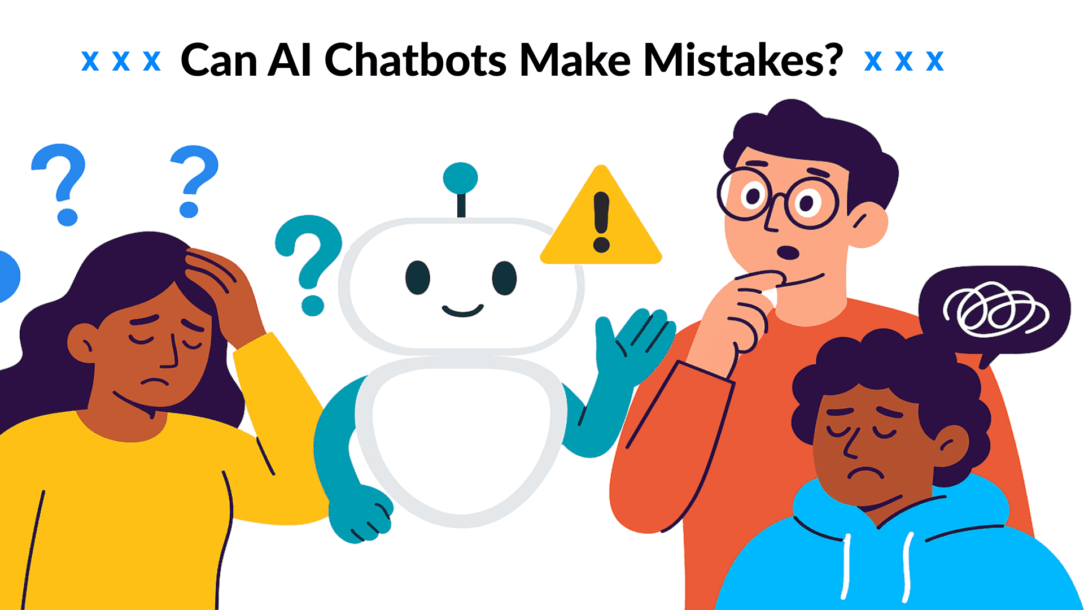Understanding AI Mistakes, Bias, Errors, and Chatbot Limitations
A report by Juniper Research explains that chatbot interactions are expected to reach 9.5 billion by 2026. This indicates that AI chatbots have today become a large part of our daily lives. Whether you are chatting with customer support, asking about online instructions, or just chatting with a Google virtual assistant, all of these are examples of AI chatbots.
Nevertheless, even though these chatbots seem smart, they can also make small mistakes while answering complex questions. But what are they? Keep on reading, and in the forthcoming content, we will be exploring how such bots work, what kind of errors they can make, and how you should use them to reap their full potential.
Understanding How AI Chatbots Work
Understanding the working process of AI chat can help to understand why they actually make mistakes. That being said, an AI-powered chatbot is a computer program designed to talk with the communicator, just as humans do, to enhance the user experience.
It uses something called Natural Language Processing (NLP) to understand what you’re saying and what would be an appropriate answer for you. Many modern chatbots are powered by machine learning, especially a type called Large Language Models (LLMs).
These models learn by studying huge amounts of text—from books, websites, chats, and more. Over time, they figure out patterns in how people talk and use that knowledge to answer questions or carry on a conversation.
Some older rule-based bots follow fixed instructions. For example, if you say “Hi,” they reply with “Hello!” But newer chatbots, like ChatGPT, are generative AI. This means they don’t just repeat rules—they create answers on the spot based on what they’ve learned.
Chatbots are also trained using reinforcement learning, where they improve over time by learning which answers are most effective. But even with all this training, they don’t actually “understand” like a human does—which is why AI mistakes and chatbot errors can still happen.
Common Chatbot mistakes
Even though AI chatbots work on advanced algorithms, they still can make some silly mistakes. Here are some of the most common mistakes artificial intelligence usually makes.
Inaccurate Information:
Chatbots can confidently give facts that aren’t true. Since they don’t know things the way people do, they sometimes make things up based on patterns in the data.
Made-Up Answers
Some bots will create answers that seem real but are completely false. For example, they might invent fake names and events. Even if you ask the bot about facts related to 2025 and the chatbot has data updated only up to 2022, it will provide some made-up statistics.
Confusing Context
If a user gives a long or tricky message, the chatbot might misunderstand what they mean. This can lead to off-topic or confusing replies.
Bias in Responses
Because chatbots learn from the internet, they can also pick up human biases, getting influenced by people’s opinions and landing on a wrong conclusion. This means they might repeat unfair or one-sided views without meaning to.
Silly or Contradictory Replies
Sometimes, chatbots say things that don’t make sense or even go against what they said earlier. For instance, you instruct the chatbot to give you updated information about trends. However, instead of this, it might start providing information about last year’s trends, which have already faded away.
Root Causes Behind These AI Errors
AI chatbots don’t make mistakes randomly—there are clear reasons behind the errors they make. Let’s break them down in simple terms:
- Training Data Problems: AI chatbots learn from large amounts of text found online—like articles, books, and websites. However, the provided dataset can be outdated and vague sometimes. For example, if the training data is from 2022, the chatbot won’t be aware of events or updates that occurred after that year. Also, if the information it learned includes biased views, the chatbot might repeat them.
- No Common Sense: Unlike humans, AI doesn’t really “understand” the world. It doesn’t know that water is wet or that you shouldn’t text while driving. So, it might say something that seems accurate at first glance but doesn’t make sense in real life.
- Complicated or Unclear Messages: If a user types a message that’s too long, unclear, or has multiple questions at once, the chatbot can get confused. It might pick the wrong part of the message to respond to or ignore something important.
- Technical Limits: AI systems have their limits. For example, they can only process a certain number of words (called tokens) at once. Also, most chatbots aren’t very adaptive—they don’t always learn from past conversations or change their behavior based on what a specific user wants.
5. Human Oversight & Responsibility to Bots
Even though AI chatbots can do many things on their own, they still need human supervision. Why? Because they don’t fully understand what they’re saying—they only guess what words should come next based on patterns. That means without someone checking their answers, mistakes can easily slip through.
Sometimes, people put too much trust in chatbots. They assume that just because the answer sounds right, it must be true. This overconfidence can be dangerous—especially in areas like healthcare, law, or finance. Imagine asking a chatbot about a medical issue and following the wrong advice. That could lead to real harm.
So, who is responsible when a chatbot makes a serious mistake? Some believe it’s the developers who build the AI—they choose what data it learns from. Others say the companies that deploy the chatbot should take responsibility because they decide how and where it’s used. And some think users must be careful and not expect too much from a machine.
The truth is everyone plays a part. Developers need to design safer, smarter chatbots. Businesses must test and monitor them closely. And users should always double-check important information, especially when it affects real-life decisions.
AI can be incredibly useful—but it’s not perfect. That’s why keeping a human in the loop is so important. We need people to guide, correct, and take responsibility for what AI tools say and do.
Top 5 ways to fix AI Errors
AI chatbots are not perfect. However, here are some proven effective ways to fix these mistakes and enhance usage efficiency.
1. Give Clear and Simple Instructions to AI Systems
Do not overcomplex the instructions while giving prompts to the chatbot. Always try to keep sentences short and ask simple questions that are easy to understand.
Example: Instead of asking, “Can you tell me all about the weather and my schedule for today?” try asking, “What’s the weather today?”
2. Provide Feedback regarding AI mistakes
If a chatbot gives a wrong or confusing answer, let the developers know. Many chatbots have ways to report mistakes or rate answers. Your feedback helps improve future responses.
Example: If a chatbot gives wrong information, click the “thumbs down” or “report” button. You can also provide written feedback by saying, “This answer is incorrect.” This way, the chatbot will get to know about the kind of mistakes it is making. Similarly, if the bot provides a written answer, click on the “Thumbs up “button or write, “This answer is correct.”
3. Use updated information
Make sure the AI chatbot you are using has all the latest data. Developers should update the chatbots regularly so that they don’t give wrong facts to the users.
Example: If a chatbot still talks about old phone models, developers should update its data with the latest releases so it doesn’t confuse users with outdated info.
4. Add safety checks to Conversational AI
Businesses can add filters to catch the pitfalls in the content before it reaches the final users.
Example: A company can add filters to stop the chatbot from saying rude or harmful things. So, if someone types something offensive, the chatbot won’t respond with similar language.
5. Keep Humans Involved
Always have real people and human agents check important or sensitive answers. Chatbots can help, but humans should make final decisions when accuracy matters most.
Example: A bank might use a chatbot to answer simple questions but have a real person handle complex issues like loan approvals to avoid mistakes.
Deploying AI Chatbots Effectively: Overcoming Bias with Tools Like Clepher
AI chatbots are powerful yet imperfect. They heavily rely on training data, prompt clarity, and user guidance. But to truly harness their potential while minimizing common pitfalls like biases, businesses need tools that strike the right balance between automation and human input.
That’s where smart platforms like Clepher come in. Rather than relying on generic, one-size-fits-all chatbot behavior, Clepher allows users to customize conversational flows and maintain brand voice throughout interactions. This ensures that the content generated stays aligned with your goals, tone, and accuracy standards.
By combining AI efficiency with human creativity, Clepher enables marketers to refine responses, guide the bot’s tone, and reduce the likelihood of errors or irrelevant outputs.
Hence, tools like Clepher help bridge the gap between raw AI capability and practical, trustworthy deployment—especially in environments where precision and personalization matter most.
Summary
AI chatbot automation has quickly become part of our daily digital tools. From answering questions to helping create content, these tools come in handy in almost all cases. But like any technology, they come with their own set of challenges as well. From misunderstood messages and outdated data to hidden biases, AI mistakes are real and worth paying attention to.
Nevertheless, with clear instructions, human oversight, and tools like Clepher, we can reduce these errors and make AI chatbots more reliable. Understanding how they work and where they fall short helps users, developers, and businesses use them more effectively.
Related Posts



